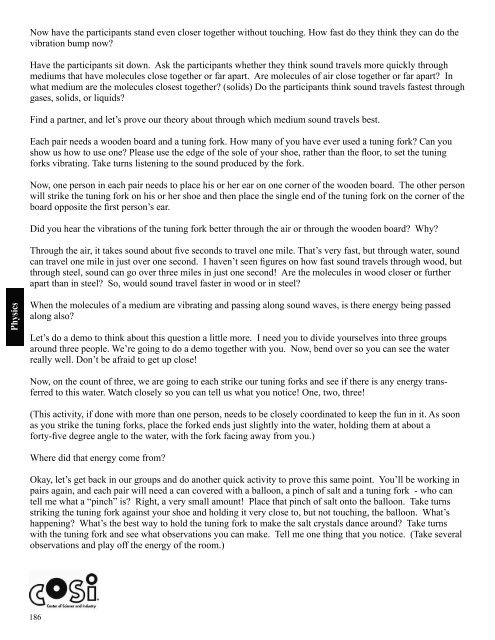ScienceMakers Toolkit Manual - The History Makers
ScienceMakers Toolkit Manual - The History Makers
ScienceMakers Toolkit Manual - The History Makers
You also want an ePaper? Increase the reach of your titles
YUMPU automatically turns print PDFs into web optimized ePapers that Google loves.
Physics<br />
Now have the participants stand even closer together without touching. How fast do they think they can do the<br />
vibration bump now?<br />
Have the participants sit down. Ask the participants whether they think sound travels more quickly through<br />
mediums that have molecules close together or far apart. Are molecules of air close together or far apart? In<br />
what medium are the molecules closest together? (solids) Do the participants think sound travels fastest through<br />
gases, solids, or liquids?<br />
Find a partner, and let’s prove our theory about through which medium sound travels best.<br />
Each pair needs a wooden board and a tuning fork. How many of you have ever used a tuning fork? Can you<br />
show us how to use one? Please use the edge of the sole of your shoe, rather than the fl oor, to set the tuning<br />
forks vibrating. Take turns listening to the sound produced by the fork.<br />
Now, one person in each pair needs to place his or her ear on one corner of the wooden board. <strong>The</strong> other person<br />
will strike the tuning fork on his or her shoe and then place the single end of the tuning fork on the corner of the<br />
board opposite the fi rst person’s ear.<br />
Did you hear the vibrations of the tuning fork better through the air or through the wooden board? Why?<br />
Through the air, it takes sound about fi ve seconds to travel one mile. That’s very fast, but through water, sound<br />
can travel one mile in just over one second. I haven’t seen fi gures on how fast sound travels through wood, but<br />
through steel, sound can go over three miles in just one second! Are the molecules in wood closer or further<br />
apart than in steel? So, would sound travel faster in wood or in steel?<br />
When the molecules of a medium are vibrating and passing along sound waves, is there energy being passed<br />
along also?<br />
Let’s do a demo to think about this question a little more. I need you to divide yourselves into three groups<br />
around three people. We’re going to do a demo together with you. Now, bend over so you can see the water<br />
really well. Don’t be afraid to get up close!<br />
Now, on the count of three, we are going to each strike our tuning forks and see if there is any energy transferred<br />
to this water. Watch closely so you can tell us what you notice! One, two, three!<br />
(This activity, if done with more than one person, needs to be closely coordinated to keep the fun in it. As soon<br />
as you strike the tuning forks, place the forked ends just slightly into the water, holding them at about a<br />
forty-fi ve degree angle to the water, with the fork facing away from you.)<br />
Where did that energy come from?<br />
Okay, let’s get back in our groups and do another quick activity to prove this same point. You’ll be working in<br />
pairs again, and each pair will need a can covered with a balloon, a pinch of salt and a tuning fork - who can<br />
tell me what a “pinch” is? Right, a very small amount! Place that pinch of salt onto the balloon. Take turns<br />
striking the tuning fork against your shoe and holding it very close to, but not touching, the balloon. What’s<br />
happening? What’s the best way to hold the tuning fork to make the salt crystals dance around? Take turns<br />
with the tuning fork and see what observations you can make. Tell me one thing that you notice. (Take several<br />
observations and play off the energy of the room.)<br />
186










